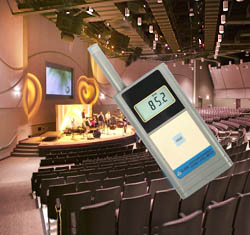It seems like every week I end up in a conversation about volume levels and that “so and so” thinks it’s too loud. Today, let’s focus on our perception of loudness.
In the space where I mix or act as producer almost every Sunday, we hold two very distinct services. The early service is more “traditional” (whatever that means) with brass, strings, organ, choir, and a worship team of vocalists.
The second service is all-out contemporary praise and worship with a little edge to it. The typical set includes drums, bass, acoustic, lead guitar, keyboard and one or two vocalists, and the musicians have mostly grown up in the 1980s and 90s, so big guitar (also used to be big hair) tend to rule the day.
We try to make sure sound pressure levels for this service don’t get out of hand, and to help get a better grip, I’ve started setting up a dB meter for every service to keep an eye on the average levels. My friend Trevor, who mixes these contemporary services, refers to it as the speedometer (and I’m not sure if he means that in a positive way).
Recently I decided to also use the meter during the traditional services so we could have some comparison. I’d expected the contemporary service to be 15 dB hotter than the traditional service, so was surprised that on certain Sundays (when the brass played), the traditional service actually hit peaks slightly hotter than the contemporary service!
For consistency, I monitored both services using a dB A-weighting. The music in the traditional service averaged around 82 dBA, with peaks running around 88 dBA. The contemporary service averaged around 85 dBA with peaks in the low 90s.
With just 3 dB separating the level of the two services, why was nobody complaining about the levels in the traditional service?
One obvious reason is that A-weighting was developed for lower volumes, and the frequency response is weighted to the human ear. This means that the low-frequency energy generated by the bass and the kick drum in the contemporary service does not register as much on the A weighted scale.
Why A-weighted measurements? OSHA loudness exposure ratings are based in A-weighting. Really, the scale of weighting, A or C, is not all that important as long as the same one is used every time—AND—we understand what the weighting represents.
But I believe the main reason we don’t get complaints is due to musical style. In the traditional service, the organist playing an offertory can easily hit 90 dBA, and people will say it is “powerful.”
In addition, the peaks in our traditional services are generally very short lived—for example, the trumpets will hit an accent note that jumps out but it’s gone in an instant.
So I maintain that it really comes down to taste and the composition of the music. I usually enjoy a 90 to 95 dBA contemporary Christian concert, but wouldn’t stay in the room for a heavy metal band playing at that same level.
My parting suggestion would be to document the levels of your services so that you have a consistent reference point to refer to. This comes in really handy when the inevitable and constant subject of volume levels rears its head again… and again… and again…
Gary Zandstra is a professional AV systems integrator with Parkway Electric and has been involved with sound at his church for more than 30 years.


















